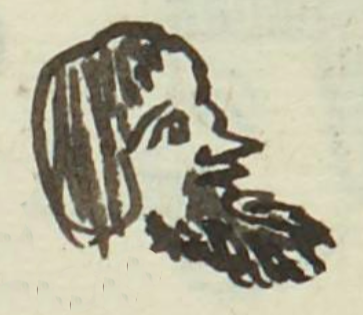Tetzon (MH522r)
This black-line drawing of the simplex glyph for the personal name Tetzon or Tentzon ("Noble," attested here as a man's name) shows the head of a man in profile, facing toward the viewer's right. He has a long, thick beard (tentzontli) protruding or sticking out. The beard serves as a phonetic indicator.
Stephanie Wood
Beards were known in the autonomous era (as this Olmec sculpture found in Puebla shows, but beards became thicker and more prevalent as European DNA became a factor as a result of colonization (whether as a result of violation or through consensual unions). Nahua and European views of hair were very different and affected how they perceived one another. For a study of some of these attitudes, see A. Turner, "Beard and Conquest," Revista de Historia Iberoamericana 6:1 (2013). The beard in this glyph seems especially black, thick, and long.
Wikipedia notes: "In the 15th century, most European men were clean-shaven. [But] 16th-century beards were allowed to grow to an amazing length (see the portraits of John Knox, Bishop Gardiner, Cardinal Pole and Thomas Cranmer). Some beards of this time were the Spanish spade beard, the English square cut beard, the forked beard, and the stiletto beard. In 1587 Francis Drake claimed, in a figure of speech, to have singed the King of Spain's beard." See below for an image of a forked beard.
Stephanie Wood
felliphe tetzon
Felipe Tentzon
Stephanie Wood
1560
José Aguayo-Barragan
beards, barbas, hair, pelos, faces, caras , nombres de hombres, tetzon, tentzon, tetzontli, tentzontli
This portrait appears on folio 665 recto of the Matrícula de Huexotzinco. The image is located on the part of the page where the Indigenous guardian over the tribute payers can be found. But this man's clothing and sixteenth-century "forked" beard (mentioned above) suggest "Spaniard." No name or title is provided on the document for this person.

tentzon(tli), a beard, or also a noble, https://nahuatl.wired-humanities.org/content/tentzontli
tetzon, a noble, or offspring (equivalent of pilli), https://nahuatl.wired-humanities.org/content/tetzon
El Noble
Stephanie Wood
Matrícula de Huexotzinco, folio 522r, World Digital Library. https://www.loc.gov/resource/gdcwdl.wdl_15282/?sp=183&st=image
This manuscript is hosted by the Library of Congress and the World Digital Library; used here with the Creative Commons, “Attribution-NonCommercial-ShareAlike 3.0 License” (CC-BY-NC-SAq 3.0).






